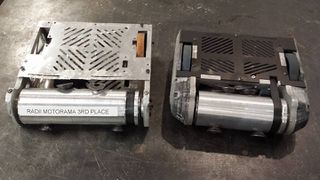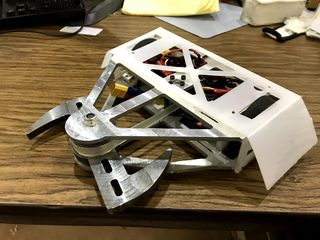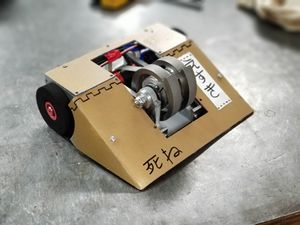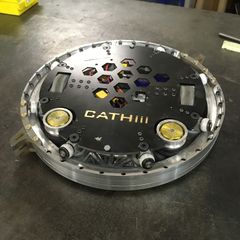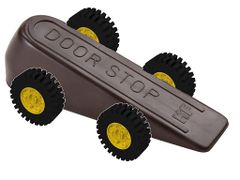3lb Beginner's Guide
Contents
Introduction
- these
- are
- place holders
Choosing a Robot
Drum Spinner
This weapon is a spinning drum with teeth at the front of the robot. It is driven similarly to a vertical or horizontal spinner with a pulley system between the weapon and weapon motor.
Pros
- Great beginner bot
- Reliable due to simple weapon
- Outputs good damage
- Weapon doesn't require too much space away from the rest of the bot
- Easy to design so it can drive while flipped
Cons
- Smaller strike zone
- Gyroscopic effect can make fast turns hard
- Large heavy weapon
Horizontal Spinner
The weapon is a flat spinning bar or disk at the front of the robot. It is also driven similarly to a drum or vertical spinner with a pulley system between the weapon and weapon motor.
Pros
- High Damage Output
- Large strike zone
- Easy to design so it can drive while flipped
- Weapon can withstand significant damage without breaking (bent weapon still functions well)
Cons
- Robot must extend out to avoid its own weapon
- Gyroscopic effect make turning fairly difficult
- Needs a lot of structural support on the weapon to prevent damage from recoil
Vertical Spinner
This weapon is a spinning ring with teeth that surrounds the entire frame. Generally, the ring is supported by "rollers" which have bearings to reduce friction and support the ring with a male-female interface. The ring is typically driven directly by the weapon motor which has a casing of a high friction material such as rubber.
Pros
- Great damage output
- Allows for the use of a wedge, which acts to as armor and directs bots into the weapon
- If the weapon breaks, it still functions as a wedge bot
Cons
- Hard to allow for driving when flipped
- Gyroscopic effect can make driving difficult
- Weapon has to be smaller to maintain low center of gravity (keep the bot short)
Ring Spinner
This weapon is a spinning ring with teeth that surround the entire frame. Generally, the ring is supported by "rollers" which have bearings to reduce friction and support the ring with a male-female interface. The ring is typically driven directly by the weapon motor which has a casing of a high friction material such as rubber.
Pros
- Perfect 360 strike zone
- Hard to compete against
- Easy to design so that you can drive while flipped
Cons
- Difficult to design and assemble
- Weapon takes all the blows and can break
- Can be difficult to drive
Wedge
It's a wedge
Pros
- Requires almost no skill to build and drive
Cons
- Doesn't properly test your abilities
- Doesn't allow for creative solutions nor any sort of design process
- Boring to watch
As a member of RoboJackets BattleBots, you are expected to build a robot, not a door stop with wheels. While they may be successful in competitions, they don't truly test your abilities as an engineer, so we discourage teams from building them. It's way more fulfilling to build something cool that doesn't work exactly like you hoped, than to have a fully functioning boring robot.
What is a Robot
Here I imagine a table, containing typical parts (weapon, motors, receiver), descriptions of the parts, typical weights and dimensions, and accompanying picture(s)
Design Process
Introduction
Here's where there will be a small speech about the importance of the design process
Step 1: Sketch
Here's a description about how the sketching process works (limited dimensions, a focus of features, roundtable discussion)
Step 2: Draw
Here's a description about how the technical drawing process works (concentration of dimensions, viewpoints, and materials)
Step 3: Picking a motor
Here's a description on how to pick a motor (math n stuff)
Step 4: CAD Parts
Here's a description about how CADing the individual parts should work (the division of labor vs team all being on the same page)
Step 5: CAD Assembly
Here's a description about how assembling the CAD parts works (things to consider regarding final CAD for design review)
Step 6: Design Review
Here's a description about the design review (what to expect)
Step 7: Revise and repeat
Here's a description about what to do after the design review
Machining
Machines and what they do
- Machine 1: Does stuff
- Machine 2: Does other stuff
- Machine 3: Profit
Rules
- Rule 1: No killing yourself
- Rule 2: Beware the spinny bit on the mill
- Rule 3: No bathing in the water jet
Tips and Tricks
- How to turn on the waterjet
- Step 1:...
- Step 2:...
- What materials to use where
- If xyz breaks, do abc
Physics and Math (Oh my!)
Here's where there will be a rehashing of the math formulas and physics properties to know
Documentation
Here's where a guide regarding documentation will be
Previous bots
Here's where links to previous bots that are good examples will be
Probably another section I'm forgetting
meme
